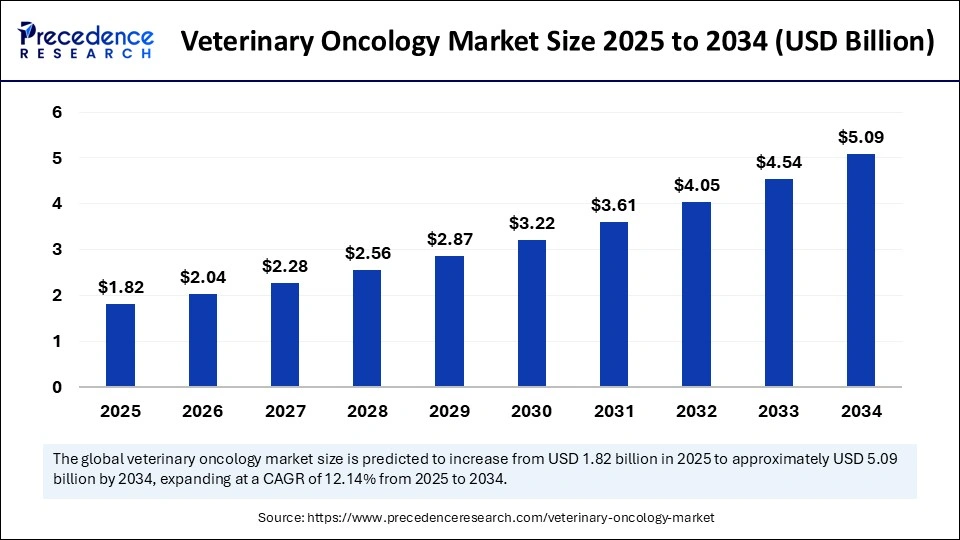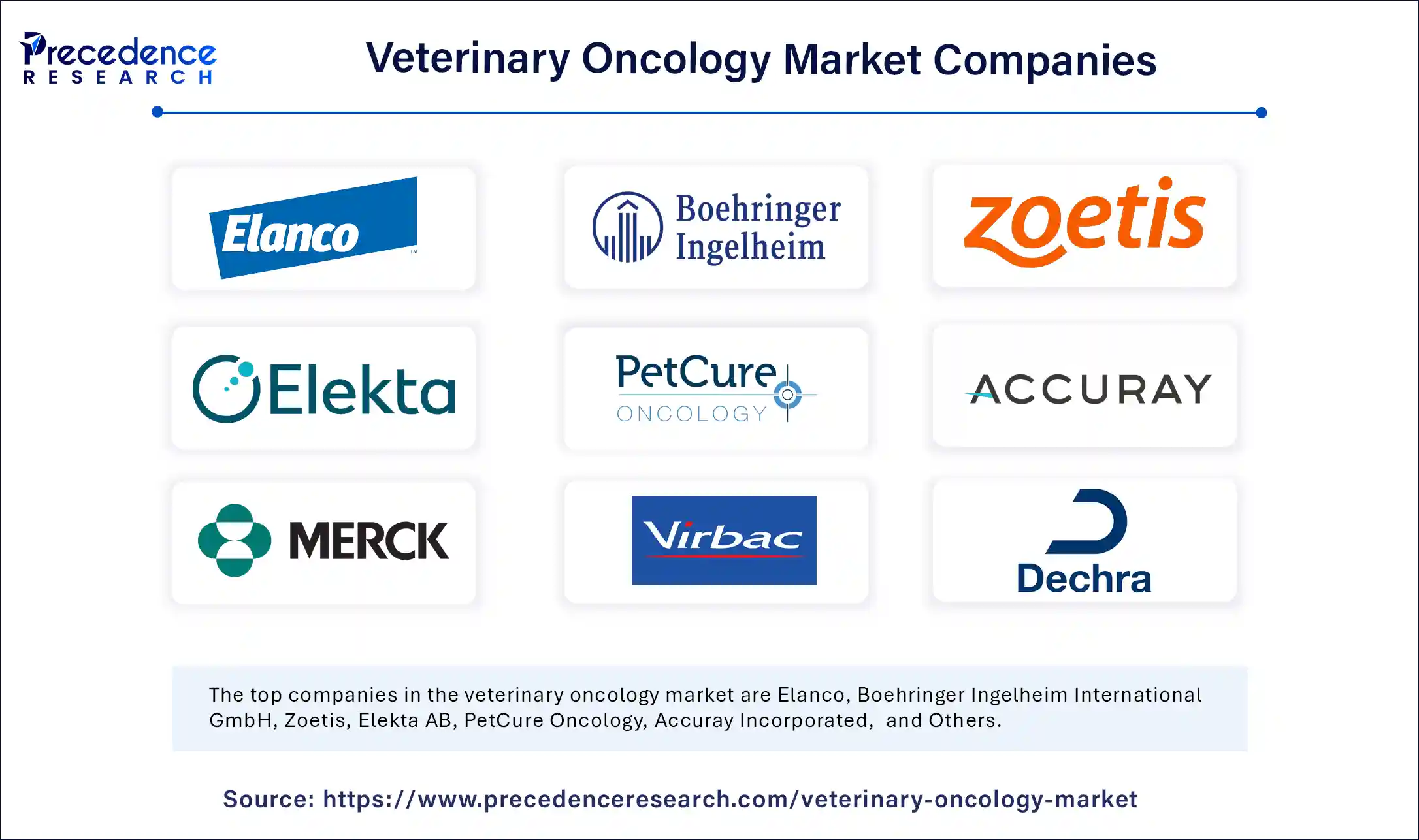
Veterinary Oncology Market Key Points
-
North America dominated the veterinary oncology market with the largest revenue share of 54% in 2024.
-
Asia Pacific is projected to grow at a notable CAGR of 12% during the forecast period.
-
By animal type, the canine segment accounted for the major revenue share of 87% in 2024.
-
The feline segment is expected to experience significant growth during the forecast years.
-
By therapy, the surgery segment led the market in 2024.
-
The immunotherapy segment is anticipated to expand at a significant CAGR of 14.21% during the forecast period.
-
By cancer type, the skin cancer segment held the dominant market position in 2024.
Veterinary Oncology Overview
Veterinary oncology is a specialized branch of veterinary medicine focused on the diagnosis and treatment of cancer in animals, particularly companion animals like dogs and cats. It involves the use of advanced diagnostic techniques such as biopsies, imaging (X-rays, CT scans, MRIs), and lab tests to detect various types of tumors. Common treatments include surgery, chemotherapy, radiation therapy, immunotherapy, and palliative care to manage pain and improve quality of life.
Importance and Advancements:
With the growing emotional and financial investment in pet care, veterinary oncology has seen significant advancements. New treatment protocols, targeted therapies, and minimally invasive procedures are improving survival rates and outcomes for pets with cancer. Veterinary oncologists work closely with pet owners to tailor treatment plans based on the type of cancer, the animal’s health, and quality-of-life considerations. As awareness increases, veterinary oncology continues to expand as a crucial field in modern veterinary practice.
How is AI Advancing Diagnosis and Treatment in the Veterinary Oncology Market?
AI is transforming veterinary oncology by enhancing the accuracy and speed of cancer diagnosis in animals. Machine learning algorithms can analyze medical imaging, pathology slides, and genetic data to detect tumors early and differentiate between benign and malignant growths. This enables veterinarians to make more informed decisions, resulting in faster and more precise treatment plans tailored to each animal’s condition.
AI is playing a critical role in personalizing cancer treatment for animals by predicting how different therapies will affect individual patients. It also accelerates research by analyzing large datasets to uncover new insights into cancer patterns, drug responses, and survival rates. Through predictive modeling and real-time monitoring, AI supports better treatment outcomes, reduces side effects, and contributes to the development of innovative cancer therapies for veterinary use.
Veterinary Oncology Market Growth Factors
Advancements in veterinary oncology treatments are at the forefront of market growth. Techniques like precision medicine, immunotherapy, stereotactic radiation, and targeted therapies—long used in human oncology—are increasingly available for pets. Regulatory approvals (e.g., Tanovea-CA1 for canine lymphoma) and expanding use of advanced diagnostics such as CT, MRI, and rapid in-clinic blood tests are enabling earlier detection and personalized treatment plans. These breakthroughs not only improve clinical outcomes but also increase pet owner demand for refined and effective cancer care.
In parallel, the increasing prevalence of cancer in companion animals and higher pet ownership are major growth engines. As lifespans lengthen, more dogs and cats are being diagnosed with cancer—statistics suggest one in four dogs and one in five cats experience the disease. This is compounded by a rise in pet humanization and healthcare spending, notably in North America and fast-growing markets like Asia-Pacific, where pet ownership and insurance coverage are expanding. Public and private investments, including government grants and awareness campaigns, are also reinforcing this trend by fostering research and infrastructure development in veterinary oncology .
Get this report to explore global market size, share, CAGR, and trends, featuring detailed segmental analysis and an insightful competitive landscape overview @ https://www.precedenceresearch.com/sample/6165
Market Scope
| Report Coverage | Details |
| Market Size by 2034 | USD 5.09 Billion |
| Market Size in 2025 | USD 1.82 Billion |
| Market Size in 2024 | USD 1.62 Billion |
| Market Growth Rate from 2025 to 2034 | CAGR of 12.14% |
| Dominating Region | North America |
| Fastest Growing Region | Asia Pacific |
| Base Year | 2024 |
| Forecast Period | 2025 to 2034 |
| Segments Covered | Animal Type, Threrapy, Cancer Type, and Region |
| Regions Covered | North America, Europe, Asia-Pacific, Latin America, and Middle East & Africa |
Market Dynamics
Market Drivers
The veterinary oncology market is primarily driven by the rising incidence of cancer among companion animals, particularly dogs and cats. With pet ownership increasing globally and animals being treated more like family members, there is a growing demand for advanced veterinary healthcare services, including oncology. Advances in diagnostic imaging, targeted therapies, and surgical techniques are enabling early detection and more effective treatment of various types of cancers in animals. Additionally, increased awareness among pet owners regarding animal health, coupled with higher spending on veterinary care, supports the adoption of oncology services. Pharmaceutical companies and veterinary clinics are also investing more in R&D for developing innovative cancer treatments, including chemotherapy, immunotherapy, and radiation therapy, which is propelling market growth.
Opportunities
The veterinary oncology market offers significant opportunities in terms of innovation and expansion. The increasing availability of precision medicine, genetic testing, and molecular diagnostics in veterinary care is creating pathways for more personalized cancer treatments in animals. Telemedicine and digital health tools also present a growing opportunity for extending oncology services to remote areas and improving follow-up care. Furthermore, emerging markets such as Latin America and parts of Asia-Pacific present untapped potential, driven by a rising middle class, expanding veterinary infrastructure, and growing awareness of animal health. Collaborations between veterinary hospitals, research institutions, and pharmaceutical companies can also accelerate the development of novel oncology solutions and enhance accessibility for pet owners.
Challenges
Despite positive growth trends, the veterinary oncology market faces several challenges. High treatment costs remain a significant barrier, especially for advanced procedures like radiation therapy or targeted biologics, which are often unaffordable for many pet owners. Moreover, limited insurance coverage for veterinary oncology procedures restricts treatment access in some regions. There is also a shortage of veterinary oncologists and specialized oncology facilities, particularly in rural or underdeveloped areas. The emotional and ethical complexities surrounding end-of-life care and treatment decisions for pets further complicate the landscape. Additionally, regulatory challenges and the lengthy development cycles for veterinary oncology drugs can delay innovation and commercialization.
Regional Outlook
North America leads the veterinary oncology market, driven by high pet ownership rates, advanced veterinary healthcare systems, and strong spending on animal care. The U.S., in particular, has a robust network of veterinary clinics and specialists offering comprehensive oncology services. Europe is another significant market, supported by a well-established veterinary sector and increasing investment in pet health. Countries like Germany, the UK, and France are at the forefront of adopting innovative treatments. The Asia-Pacific region is poised for rapid growth due to rising pet adoption, expanding urbanization, and increasing awareness about animal health. However, the region still lags behind in terms of specialized oncology services. Latin America and the Middle East & Africa represent emerging markets with moderate growth potential, driven by evolving pet care trends and gradual improvements in veterinary infrastructure.
Veterinary Oncology Market Companies

- Elanco
- Boehringer Ingelheim International GmbH
- Zoetis
- Elekta AB
- PetCure Oncology
- Accuray Incorporated
- Varian Medical Systems, Inc. (parent company: Siemens Healthineers)
- Virbac
- Merck & Co., Inc.
- Dechra Pharmaceuticals PLC
- NovaVive Inc.
- Ardent Animal Health, LLC (A Breakthrough Company)
Segments Covered in the Report
By Animal Type
- Canine
- Feline
- Equine
By Therapy
- Radiotherapy
- Stereotactic Radiation Therapy
- LINAC
- Other Types
- Conventional Radiation Therapy
- Surgery
- Chemotherapy
- Immunotherapy
- Other Therapies
- Stereotactic Radiation Therapy
By Cancer Type
- Skin Cancers
- Lymphomas
- Sarcomas
- Others
By Region
- North America
- Latin America
- Europe
- Asia-pacific
- Middle and East Africa
Also Read: Veterinary Diagnostics Market
Source: https://www.precedenceresearch.com/veterinary-oncology-market
You can place an order or ask any questions, please feel free to contact at sales@precedenceresearch.com|+1 804 441 9344